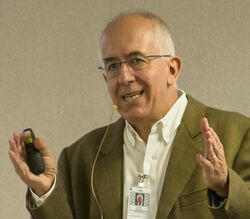Biography:Pietro Perona
Pietro Perona | |
|---|---|
 2014 at Lawrence Livermore National Laboratory | |
| Born | 3 September 1961[1] Padua, Italy |
| Nationality | Italian, American |
| Alma mater | University of Padua University of California, Berkeley (1990, PhD) |
| Known for | Computer vision Machine learning Cognitive neuroscience |
| Awards | Longuet-Higgins Prize (2013), Koenderink Prize (2010) |
| Scientific career | |
| Fields | Computer Science |
| Institutions | California Institute of Technology |
| Doctoral advisor | Jitendra Malik |
| Doctoral students | Fei-Fei Li Jean-Yves Bouguet Stefano Soatto |
| Website | www |
Pietro Perona (born 3 September 1961) is an Italian-American educator and computer scientist. He is the Allan E. Puckett Professor of Electrical Engineering and Computation and Neural Systems at the California Institute of Technology and director of the National Science Foundation Engineering Research Center in Neuromorphic Systems Engineering. He is known for his research in computer vision and is the director of the Caltech Computational Vision Group.[2]
Academic biography
Perona obtained his D.Eng. in electrical engineering cum laude from the University of Padua in 1985 and completed his Ph.D. at the University of California, Berkeley in 1990.[1][3] His dissertation was titled Finding Texture and Brightness Boundaries in Images, and his adviser was Jitendra Malik.[4] In 1990, Perona was a postdoctoral fellow at the International Computer Science Institute at Berkeley. From 1990 to 1991, he was a postdoctoral fellow at the Massachusetts Institute of Technology in the Laboratory for Information and Decision Systems.[5] He has been on the faculty of the California Institute of Technology since 1991, and he was named Allan E. Puckett Professor in 2008.[3]
Research
Perona’s research focuses on the computational aspects of vision and learning. He developed the anisotropic diffusion equation, a partial differential equation that reduces noise in images while enhancing region boundaries. He is currently interested in visual recognition and in visual analysis of behavior. [6] [7] [8] Perona and Serge Belongie lead the Visipedia project, which facilitates research on visual knowledge representation, visual search, and human-in-the-loop machine learning systems. [9] [10]
Perona pioneered the study of visual categorization (including the publication of the Caltech 101 dataset) for which he was awarded the Longuet-Higgins Prize in 2013.[11] He is also the recipient of the 2010 Koenderink Prize for Fundamental Contributions in Computer Vision,[12] the 2003 Conference on Computer Vision and Pattern Recognition best paper award,[13] and a 1996 NSF Presidential Young Investigator Award.
Media coverage
Perona has been quoted or had his research featured in various national media outlets, including the New York Times ,[6][14][15] Science Friday,[16] The New Yorker,[17] and the Los Angeles Times .[18] In 2003, Perona and Stephen Nowlin organized the NEURO art exhibition, which brought together contemporary artists and scientists to explore neuromorphic engineering. [19]
References
- ↑ Jump up to: 1.0 1.1 Perona, Pietro; Malik, Jitendra (1990). "Scale-space and edge detection using anisotropic diffusion". IEEE Transactions on Pattern Analysis and Machine Intelligence 12 (7): 629–639. doi:10.1109/34.56205. https://authors.library.caltech.edu/6498/1/PERieeetpami90.pdf.
- ↑ "Computational Vision: [Home]". http://www.vision.caltech.edu.
- ↑ Jump up to: 3.0 3.1 Pietro Perona at the Caltech directory
- ↑ Pietro Perona at the Mathematics Genealogy Project
- ↑ Pietro Perona at the Simons Foundation
- ↑ Jump up to: 6.0 6.1 Gorman, James (3 February 2014). "To Study Aggression, a Fight Club for Flies". https://www.nytimes.com/2014/02/04/science/to-study-aggression-a-fight-club-for-flies.html.
- ↑ Buchen, Lizzie (2 December 2009). "Behaviour: Flies on film" (in en). Nature 462 (7273): 562–564. doi:10.1038/462562a. ISSN 0028-0836. PMID 19956235.
- ↑ Reiser, Michael (June 2009). "The ethomics era?" (in en). Nature Methods 6 (6): 413–414. doi:10.1038/nmeth0609-413. ISSN 1548-7105. PMID 19478800. https://www.nature.com/articles/nmeth0609-413.
- ↑ "Visipedia". https://sites.google.com/visipedia.org/index/home.
- ↑ Belongie, Serge; Perona, Pietro (2016). "Visipedia circa 2015". Pattern Recognition Letters 72: 15–24. doi:10.1016/j.patrec.2015.11.023. Bibcode: 2016PaReL..72...15B.
- ↑ "Longuet-Higgins Prize". https://www.computer.org/web/tcpami/longuet-higgins-prize.
- ↑ "ECCV 2010, 11th European Conference on Computer Vision - Awards". https://projects.ics.forth.gr/eccv2010/awards.php.
- ↑ "CVPR Best Paper Award". http://www.computer.org/portal/web/tcpami/CVPR-Best-Papers.
- ↑ Hart, Hugh (2007-03-04). "Mojo - Interactive Sculpture - Christian Moeller". The New York Times. https://www.nytimes.com/2007/03/04/arts/design/04hart.html.
- ↑ Ricadela, Aaron (2005-03-10). "New System Enhances Images in Crime Investigation". The New York Times. https://www.nytimes.com/2005/03/10/technology/circuits/new-system-enhances-images-in-crime-investigation.html.
- ↑ Tu, Chau (9 January 2017). "An Algorithm to Identify Every Tree". https://www.sciencefriday.com/articles/an-algorithm-to-identify-every-tree/.
- ↑ Twilley, Nicola (22 August 2014). "Out of Many, One: The Science of Composite Photography". The New Yorker. https://www.newyorker.com/tech/annals-of-technology/out-of-many-one.
- ↑ Smith, Doug (27 July 2016). "L.A. Wants Caltech and Google to count the city's trees". http://www.latimes.com/local/lanow/la-me-ln-tree-counting-algorithm-20160726-snap-story.html.
- ↑ Muchnic, Suzanne (16 February 2006). "Avant science". https://www.latimes.com/archives/la-xpm-2003-feb-16-ca-muchnic16-story.html.
External links
 |

